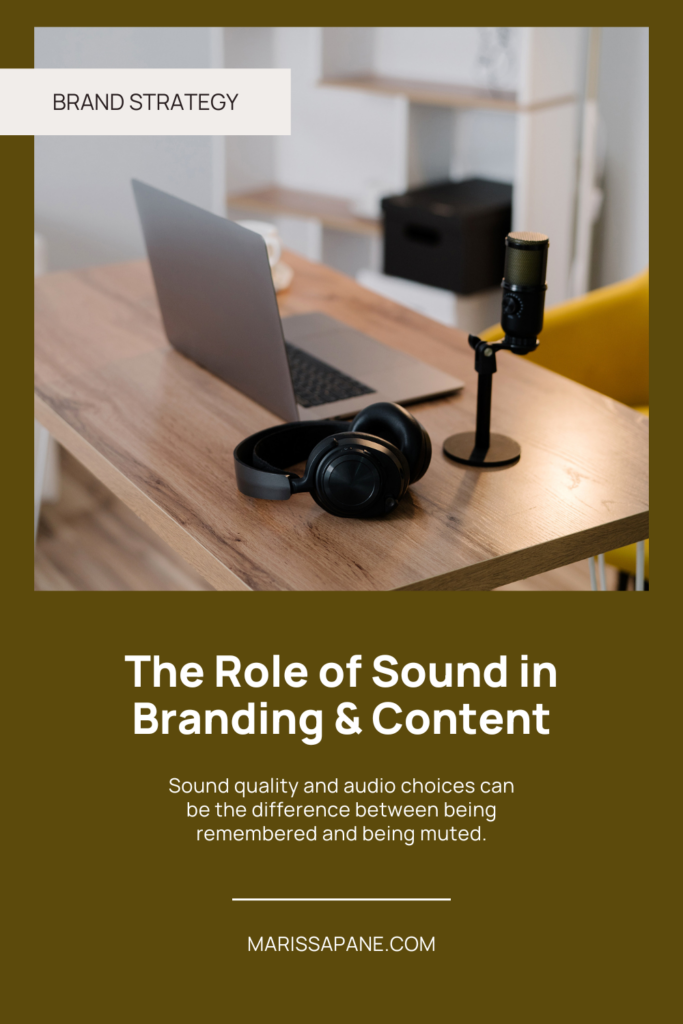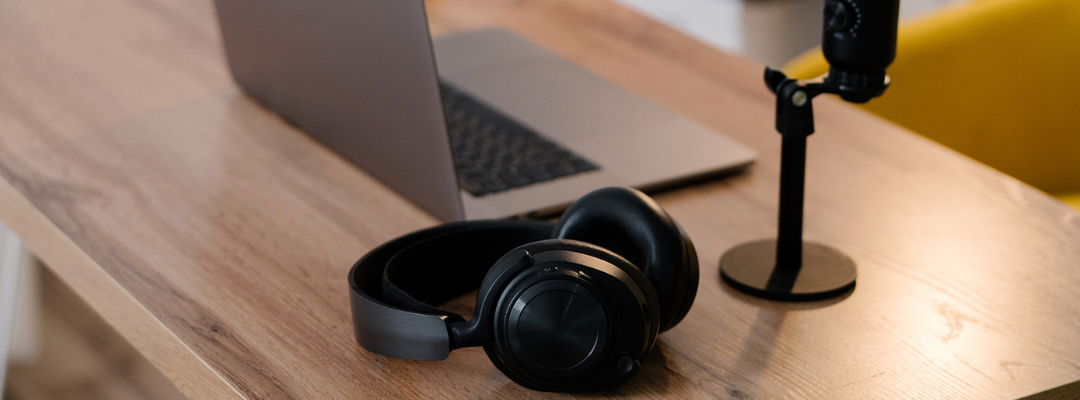While you’re busy obsessing over your font choices and color schemes, you’re completely overlooking one of the most powerful elements of brand communication: sound.
It’s that thing that’s always there, but you don’t pay attention to it until it’s a problem.
I recently sat down with Julian Blackmore—a composer, musician, and audio specialist—on my podcast “Your Brand Is Showing” to dig into this criminally overlooked aspect of branding.
🎧 Listen on: Apple Podcasts | Spotify

Julian is a British noise maker based in the Hudson Valley, New York, where he writes, produces, and performs music and sound for film, digital media, and theatre.
Julian’s music has been performed, and used in theatre and media productions around the globe, including India, South Africa, Australia and Dubai. If you watch enough unscripted telly, you’ve probably (inadvertently) heard his work.
Before relocating to New York Julian toured internationally with top UK tribute band Abba Forever, and with 70s crooners Smokie. He played keyboards, sang, and hosted for the world famous Cafe Wha? Band in Greenwich Village, NYC for eight years before the pandemic struck and forced him to put his skinny jeans into storage.
His rescue cat, Willow, tends to ghostwrite most of his music and critique his sound design choices.
More shizzle at www.julianblackmore.com
Sound: The Brand Element You’re Sleeping On
Here’s a question I want you to sit with for a minute: Have you ever watched a video on mute and felt something was missing? Or listened to a podcast with scratchy audio and immediately clicked away? That’s the power of sound at work.
Julian explained it perfectly: “People might not be able to say, ‘Oh, this bit has too much high end,’ and they might not be able to point exactly to what the problem is, but bad audio just sounds ‘nope.’“
Sound triggers two powerful responses in our brains:
- Memory Connection: Certain sounds instantly transport us back to specific moments. (That ice cream truck jingle still makes you feel like a kid, doesn’t it?)
- Conditioned Response: We’re conditioned to feel certain emotions based on musical patterns we’ve heard throughout our lives. (There’s a reason horror movies all use similar sounds.)
This means the audio you choose isn’t just background noise—it’s actively shaping how people feel about your brand. It’s either elevating your message or making you sound like every other jabroni.
Finding Your Brand’s Sound
So how do you choose the right audio for your brand? As Julian said, “Think about your mission statement. That will guide you in terms of what the music should be.”
It’s honestly common sense for the most part. For example, if you’re a holistic wellness practitioner, heavy metal probably isn’t the right fit for your Instagram Reels (unless that’s your unique angle, in which case, rock on).
Your audio choices should always reflect who you are as a brand and speak directly to the people you want to work with.
Why You Sound Like Everyone Else
One of the biggest mistakes I see service providers making is relying on trending audio just because it’s trending (and not because it aligns with their brand).
As for stock music libraries, they come with several drawbacks:
- Time-consuming AF: You’ll spend hours searching through thousands of tracks
- Not exclusive: Your competitors could use the same audio (and now you’re both looking a fool)
- Limited customization: You can’t easily modify the files (what you see is what you get)
- Generic feel: Most stock music sounds… well, like stock music
Think about how much your time is worth. Is it really saving you money to spend 3 hours searching for the “perfect” track that’s ultimately just “good enough”?
The Power of Audio Storytelling
Every piece of content you create tells a story, and sound plays a crucial role in that narrative. Julian referenced the book “Seven Basic Plots,” which breaks down every story into one of seven fundamental structures:
- Overcoming the Monster (Star Wars)
- Rags to Riches (Cinderella)
- The Quest (Lord of the Rings)
- Voyage and Return (Back to the Future)
- Comedy (The Big Lebowski)
- Tragedy (Citizen Kane)
- Rebirth
When creating content, think about which plot structure you’re using and choose audio that enhances that journey. Even that viral cat video set to “Sail” by AWOLNATION was telling a tiny story of overcoming obstacles.
Quality Matters: Don’t Insult Your Audience
One point Julian hammered home was that there’s absolutely no excuse for poor audio quality in 2025. His exact words: “Don’t insult your audience by assuming it’s okay to post a piece of sh*t.” (love him for keeping it real LOL)
Your audience has access to SO much content nowadays with pristine audio. When they encounter your scratchy podcast or echoey Instagram Story, the contrast is jarring—even if they can’t articulate exactly why.
The good news is that improving your audio quality doesn’t have to require a studio setup:
- Invest in a basic microphone (you can even get one that plugs into your phone for social content)
- Pay attention to room acoustics (avoid bathrooms, kitchens, and empty rooms)
- Keep your finger away from the microphone when recording
- Check your levels before recording (not too loud, not too soft)
- Use headphones to monitor what you’re actually capturing
The Return on Investment for Good Audio
Let’s talk money. Professional audio might seem like an unnecessary expense, especially when you’re just starting out. But consider this:
- How many potential clients have you lost because they clicked away from your content before consuming it?
- How much time have you wasted searching for “good enough” music?
- How is generic, forgettable audio affecting your brand recognition?
As Julian put it: “It may work out cheaper to actually pay someone to do it.” When you factor in the time spent searching, the limitations of stock music, and the potential impact on your audience, professional audio starts looking like a smart investment.
Audio Is Part of Your Brand Strategy
Sound isn’t just an afterthought—it’s a crucial element of your brand strategy. Just like your visual identity, your audio should be:
- Consistent across platforms
- Memorable and distinctive
- Aligned with your brand values
- Appealing to your target audience
When done right, sound can trigger instant brand recognition (think about the HBO static intro or the McDonald’s “I’m lovin’ it” jingle).
Listen Before You Create
One final tip from our conversation: pay attention to how you respond to audio as a consumer.
“If you see yourself turning something off, be aware that you turned it off and try to figure out why,” I suggested during our chat. “You’ll start to see that sometimes you turn off a piece of content because the audio was a little scratchy, or you’ll be like, ‘this music just didn’t sit right with me.'”
These instinctive reactions are gold mines of information for your own content creation.
The Bottom Line: Sound Matters
If there’s one takeaway from my conversation with Julian, it’s this: don’t underestimate how important audio quality and sound is in your content.
In a world where everyone is creating content, sound quality can be the difference between being remembered and being muted. It can amplify your message or completely undermine it.
Want to dive deeper into the power of sound in branding? Listen to the full episode with Julian Blackmore on the “Your Brand is Showing” podcast.
🎧 Listen on: Apple Podcasts | Spotify

